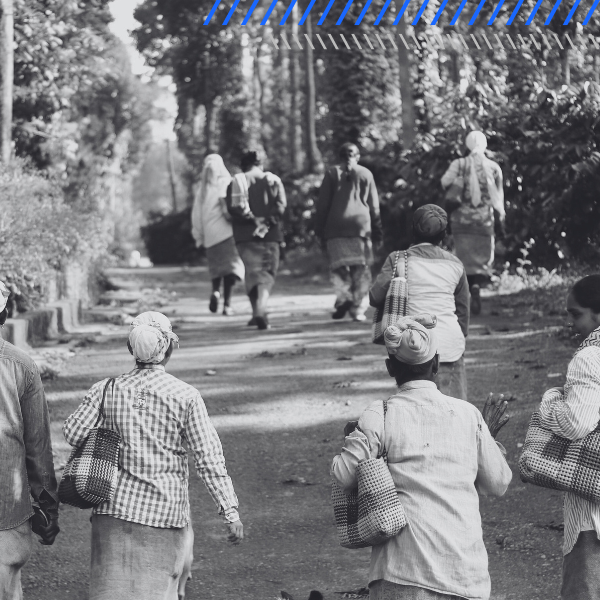With accelerating climate crises gripping the world, Funding Associate, Gopika Mahapatra analyzes how migration is an underemphasized yet acutely integral part of the picture.
As the impacts of climate change mount, millions of people are made vulnerable to its consequences. Extreme weather events, increased pollution levels, and disruptions in food security to name just a few. The larger focus on combating climate change however, remains on long term strategies of emission reduction and sustainable energy transitions, ignoring ongoing realities of climate change such as forced climate migration. Climate migration is a term used to describe increasingly unlivable conditions created by severe climate change and people’s attempts to escape them. Be it extreme weather events, or polluted air and water resources, widespread climate devastation is robbing people of their lives and livelihoods alike.
According to the UN, extreme weather events, including heavy rainfall and droughts, have already caused an average of more than 20 million people1 to leave their homes and migrate within their countries. Countries in the Global South like Pakistan, Philippines, China, Nigeria, and India lead this list with the highest levels (2) of climate migrants. India alone will see 45 million people forced to migrate from their homes by 20503 due to climate disasters. On the other hand, global investments in addressing climate migration remain disproportionately low. The current climate adaptation finance gap is estimated at a staggering US$194-366 billion yearly4. Climate adaptation refers to action taken to prepare for and adjust to the current impacts of climate change. Developing countries require over 50% more financing than previously estimated to effectively increase adaptation efforts and protect vulnerable populations. Even within this financial shortfall, 10-18 times larger than current international public finance flows, climate-induced migration remains an overlooked priority.
Consider the case of Protima Rai (3), a former Sunderbans’ resident. Sunderbans is known to be home to the world’s largest mangroves. The aftermath of Cyclone Bulbul (5), formed in the Bay of Bengal in 2019, affected the lives of hundreds of residents in surrounding areas of the forest. Journalist Murali Krishnan reported in 2023 that Rai (27), was forced to move along with hundreds of families from her village to safer areas in an effort to escape the devastation. Substantial migration from the Sundarbans still continues on a permanent, seasonal, and temporary basis. According to the Rural Household Survey, over 25%(3) of the principal earners in families migrated post the cyclone in search of work. Many people from villages across the region are also being forced to migrate to cities (Kolkata in this case), because their fertile land is turning saline with an increasing number of storms and floods. However, employment options are severely limited for these migrants. There is no structured policy or action plan from the administration to provide social protection for them. Even a country like India, which has robust climate action plans at the national and sub-national levels, does not adequately address climate migration as an integral part of these frameworks.
In today’s world, migrants driven solely by economic motives and choice, already grapple with complex issues such as mental health challenges, isolation and poor work environments (6). For climate migrants, devoid of any choice, this plight exacerbates, rendering them doubly marginalized and profoundly vulnerable. While the United Nations’ Sustainable Development Goals (SDGs) and the Sendai Framework for Disaster Risk Reduction (SFDRR) recognize such migrants as a key group that is highly exposed because of their circumstances, international refugee law still does not acknowledge the term “climate refugee”(7). This type of migration does not qualify for protection under existing policy, such as the 1951 Refugee Convention. In the absence of an officially recognised status, those who get displaced or lose their livelihoods due to environmental disasters are often left to fend for themselves.
Climate change does not just pose a threat by causing immediate harm to people and infrastructure, it is also a long-term danger that can slowly destabilize societies and economies by adversely impacting people’s well-being (8) through multiple channels of labor productivity, working and living conditions, food security, access to water and natural resources, consumption of electricity, health outcomes, destruction of assets, crime, political tensions, and instability. While research is beginning to identify the link between the adverse effects of climate change and different types of human mobility (9), the absence of any serious discussion on climate-induced displacement in mainstream climate discourse reiterates the urgency of focusing greater attention on climate migration. This need is further underscored by reports such as a recent World Bank Groundswell10 report which indicates that climate change could lead to 216 million people to move within their countries by 2050 if no urgent action is taken.
In 2022, Pradyut Bordoloi, parliamentarian from the Indian state of Assam, introduced the Climate Migrants (Protection and Rehabilitation) Bill (11) in the Indian Parliament, acknowledging this emerging crisis. The Bill outlines a framework for the protection and rehabilitation of climate-displaced persons by providing a dedicated climate fund.As governments prepare for this snowballing issue by rethinking existing legislation and policies, they can be supported by targeted development projects that address the struggles of climate migrants. Funders investing in climate change mitigation today can aid this process by recognising climate migration as a core consequence of climate change and investing in projects that help the lives of those displaced. Further, industries can also play their part in this by investing in worker welfare initiatives to train and upskill such migrant workers and implement interventions that improve work environments for migrant workers overall.
Photo by Sujeeth Potla on Unsplash.
Have any thoughts, ideas or questions that you would like to share? Write to gopika.m@goodbusinesslab.org.
Citations:
1 Climate change and disaster displacement (UNHCR)
2 Climate change displacement: ‘One of the defining challenges’ (Al Jazeera)
3 India: Migration from climate change getting worse (DW)
4 A new climate emergency emerges in adaptation finance needs (The Hindu)
5 Cyclone Bulbul kills 10, 2.73 lakh families affected in West Bengal (Business Line)
6 International Migration Report (UN)
7 How climate change impacts refugees and displaced communities (UNHCR)
8 Conflict in a changing climate (EPS)
9 The RCM Guide: a novel protection tool for crossborder disaster-induced displacement in the Americas (FMR)
10 Environmental Migration (MDP)
11 The Climate Migrants (Protection and Rehabilitation) Bill (SANSAD)


